Playing games
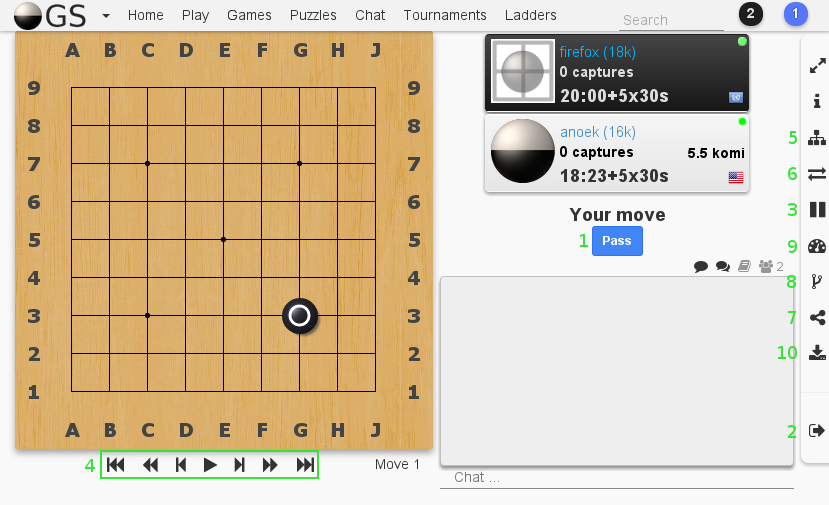
Making moves
By default all you need to do when playing a normal live or blitz game is click on the board to make a move.
When playing a correspondence game however the default move mode is to place your stone and then confirm your placement by hitting "Submit Move" button

You can change these behaviors under settings ( https://online-go.com/user/settings )
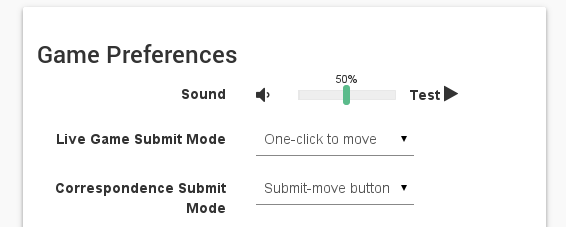
Chatting with your opponent and spectators
To talk to your opponent simply enter the message in the area where it says "Chat..." and hit enter.
Your message will appear in the chat area above, and can be seen by your opponent and any spectators which may be watching the game.
If you are a spectator, your messages will only be visible to other spectators until the end of the game (at which point the players will be able to see your messages as well).
Chat messages are saved with the game, so even if you leave and come back you will be able to see all messages anyone has written.
Passing
When it's your move, you have the option of passing instead of placing a stone. Note that when both players pass, this signals the end of the game and the players enter the stone removal phase.
To pass, click the "Pass" button, as seen on the above screenshot with the "1" next to it.
Resigning or Canceling a game
If you are confident you have lost, it is not necessary (or even courteous) to play out the game until the end. You may resign from a game by clicking the Resign icon, which is the last icon located on the right side of the screen (denoted 2 in the above screenshot).
If the game is just getting started but for some reason you are unhappy with your opponent, you can also cancel a game within the first few moves, this is done in the same way a resign is done, but the result of the game will not be counted against you or your opponent, the game is effectively annulled.
Requesting and granting an undo
If you've made a mistake, you can request an Undo to undo your last move. To do this, click the "Undo" button above the chat area (Note, this button will only be visible when it's not your turn)

If your opponent has made a mistake and clicked the undo button, then you will see the option to accept the undo

Clicking accept will undo the last move made. Ignoring the message and placing a stone, or clicking pass will ignore the undo request.
Pausing and resuming a game
If you need to pause the game for any reason, clicking the pause button (labeled 3) will stop the game clock. Note that this only pauses the clock, the game can still be played normally if you'd like.
When the game is paused, both players will see a resume button which they can click to resume the clocks.

Either player can resume the game at any point, so you should always let your opponent know the reason for the pause and let them know how long you intend to pause for, as they may not allow the pause and thus resume the game.
Reviewing past moves
To see past moves in a game you can use the turn navigation arrows found at the bottom of the board (or on the right side if you are in fullscreen mode). These are labeled 4 in the screenshot.
From left to right the icons perform the following actions
- Go to the beginning of the game
- Go back 10 moves
- Go back one move
- Auto-play the game (at 10 seconds per move)
- Step forward one move
- Step forward 10 moves
- Go to the last move made
Analyzing a game
Clicking the analyze game button (labeled 5) will put you into a game analysis mode where you can freely explore variations of the game. It will also open up the move tree which looks something like this
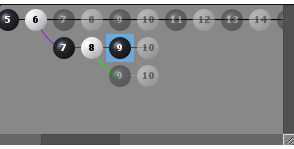
This display shows you where you are in the game. You can click on any of the moves in this tree to go to that move and show you what state the game was in when it was made. You can freely "place" stones on the board to explore different variations and see how things play out.
If you want to share a variation (aka board position) with other members in the chat, you can name your variation and click "Share", which will put a link that other users can click to see your variation.
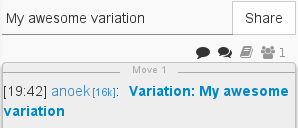
Pro tip
You can jump to when a particular move was made by shift-clicking the move on the board, this will jump you to the point in the move tree when that stone was placed.
Planning conditional moves
Note this option is only available when it is not your turn
When you are playing a correspondence game it is often the case that you can anticipate where your opponent might make their next move. You can use the conditional move planner (labeled 6) to provide responses to specific moves. If your opponent makes a move you've anticipated, the system will automatically make your next move for you so that your opponent can then make their next move immediately instead of having to wait for you to respond. You can specify as many moves in advance as you'd like, and account for as many possible variations as you can think of.
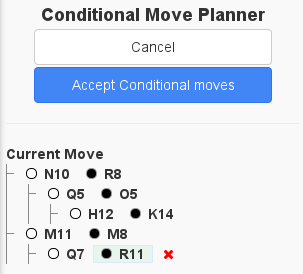
After entering the conditional move planner you can start your planning by simply making moves on the board. You'll see your "conditional move tree" (shown above) grow as you plan out your moves. To make plans for different responses from your opponent, simply click the move in the conditional move planner and continue making moves.
To remove a variation, click the response move (in this case 'black') to see a red x appear. Clicking the red x will remove that conditional move branch.
Once you are done, click "Accept conditional moves" to save your changes.
The stone removal phase
After both players have passed you will enter the stone removal phase.
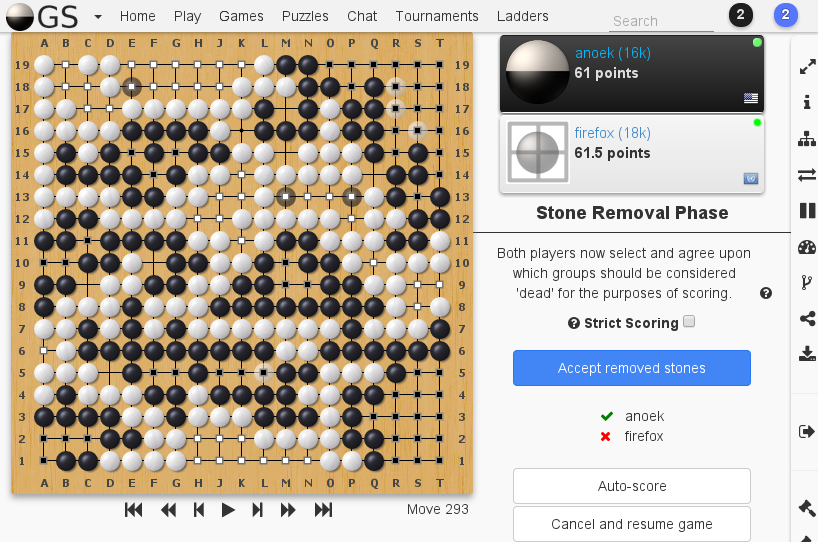
Here you may select dead stones and mark dame by clicking the stones or area on the board. After the state of the stones is agreed upon by both players, click the "Accept removed stones" button. Once both players have accepted the stones, the game will conclude.
Game scores are final
Once both players have accepted the outcome of a game, there is no way to undo or alter the game state (not even the administrators have this capability), so double check that everything looks right before you accept!
The Auto-score button attempts to automatically determine what stones are alive or dead. There are many times where this can produce inaccurate results, so it should never be counted on.
If you and your opponent cannot agree upon the state of the game, or if you missed something, you can click the Cancel and resume game button to pick up where you left off and continue playing the game. Passing twice again will bring you back to the stone removal phase.
Linking to games
If you wish to share a link to this game with another person, you can either copy and paste the URL from your browser to your friend, or you can click the share icon (labeled 7) to open up a dialog box that contains the link to copy and paste to your friend.
Forking a game
Game forking is when you start playing a game from a particular board position. So for instance, if you want to start playing a game starting at a particular move from another game, you can click the fork game button (labeled 8) to challenge another player or the computer. When the game begins, you will start at the same position you were looking at when you clicked "fork game".
Downloading SGFs
SGF files (which many Go programs can use to load a game) can be downloaded from any game by clicking the SGF download button (labeled 10). Note that if you have created a game where analysis mode has been disabled, you cannot download an SGF of it until the game has concluded.
The SGF will contain all of the moves made throughout the game along with the chat log.
Updated less than a minute ago